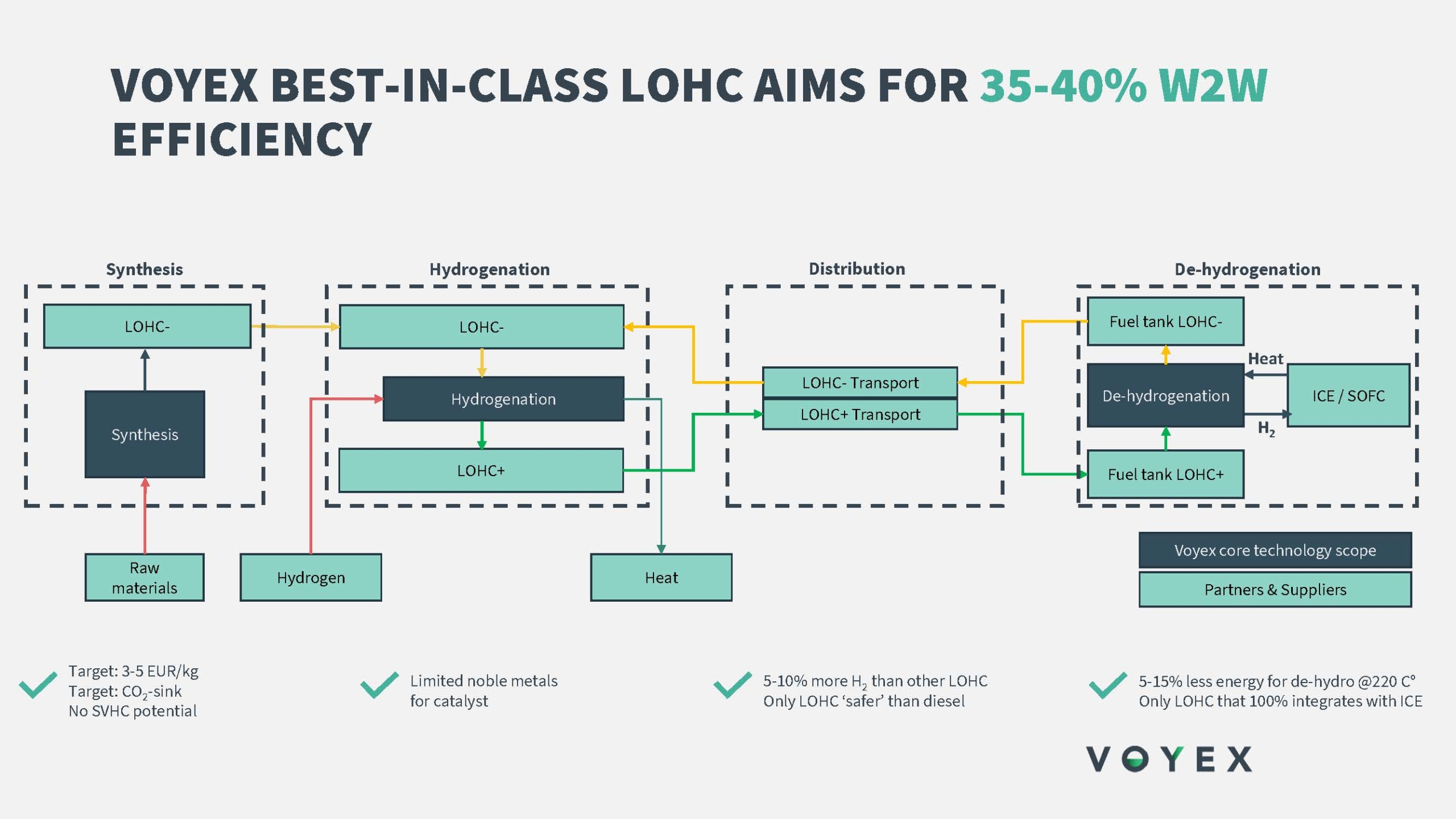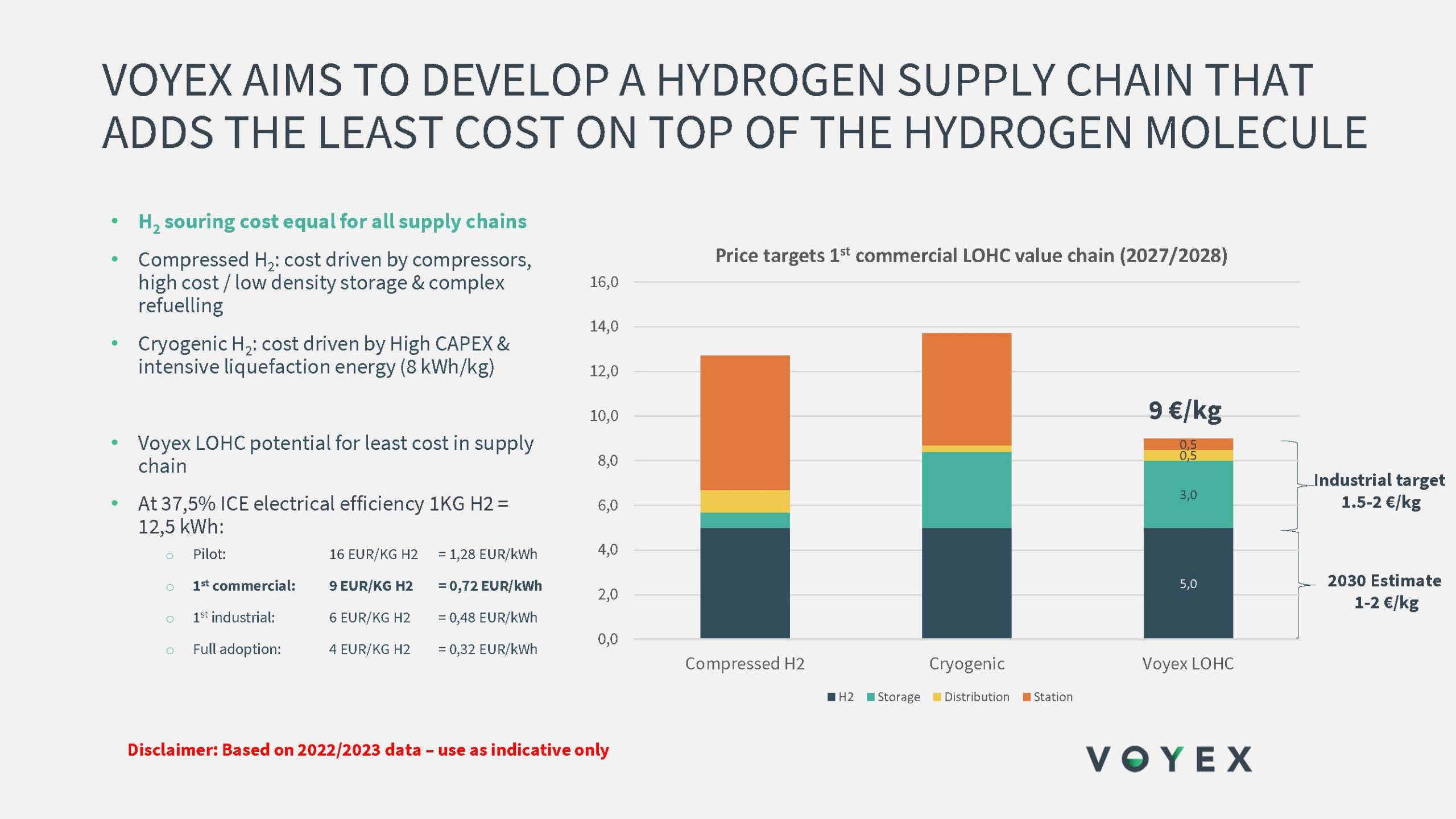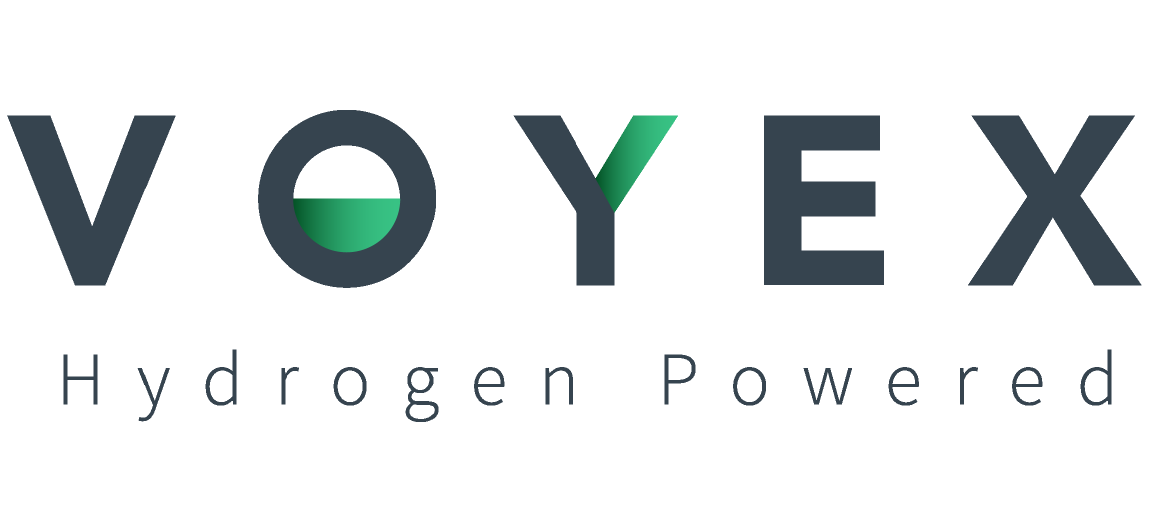When discussing energy efficiency, the challenge is to take all relevant parameters across the supply chain into account. This involves processes from (hydrogen) production to distribution and to end use. In the case of Voyex technology, end use takes place in internal combustion engines. All these aspects impact the total value chain energy efficiency. This makes it complex to create comparable calculations between the many available options. In practice, only one or two aspects are often addressed, which can create an incomplete analysis and therefore unreliable conclusion.

- Efficiency in (H2) production.
In the case of green hydrogen, production efficiency depends on the technology used in the electrolyser, e.g. PEM, Alkaline SOE. The local price and availability of clean energy determines the cost-efficiency of production, which is a reason to believe that sunny and windy regions, and places with thermal energy sources will play a significant role in hydrogen production in the near future.
- Efficiency in transport, storage and distribution.
A core focus of the Voyex solution, conversion depends on the energy and assets required for these operations as well as the amount of energy that can be transported. Transport of gaseous hydrogen, for example, requires special (costly) high-pressure tanks and permits and is linked to the gas’ energy density which is relatively low. Another example is ammonia, which has a high-hazard profile and requires special sealed (costly) tanks and can’t be stored anywhere near the built environment even though its energy density is relatively high.
- The efficiency of the equipment that consumes the hydrogen as fuel must be taken into consideration.
Typically, this will be a fuel cell with an efficiency of some 60-70%. The H2-ICE option has entered the stage of an accepted Zero Emission (ROAD) solution with an efficiency of around 38-42%. It can run on a lower grade of hydrogen and has a proven robust technology which impacts both CAPEX and OPEX costs.
Bottom-line, an energy efficiency between 20-25% is currently obtained across the hydrogen supply chain. This means that a lot of energy is lost primarily to heat loss and inefficient equipment. Some inefficiencies can be addressed and resolved, e.g., by optimizing components in the electrolyser. In other instances, the laws of physics and economics limit possibilities for optimization.
Voyex LOHC has favourable characteristics that limit energy loss, costs and time across the supply chain (albeit it doest not influence green hydrogen production). Voyex LOHC is safer than diesel, has a lower toxicity profile and can be stored at ambient temperature and atmospheric pressure, which makes it relatively easy to get permits even within the built environment. But the greatest efficiency win is the relelatively low temperature required for de-hydrogenation (getting the hydrogen out of the LOHC). As a result, Voyex LOHC can be used as a replacement for diesel fuel by using a hydrogen combustion engine (mostly converted diesel engines). The energy (heat) present in the exhaust gases of the ICE is sufficient to decouple the hydrogen from the carrier fluid (at a relative low temperature of 200-220 degrees centigrade). Therefore, using the hydrogen as fuel is a great option for greening heavy duty diesel applications.

As a result, Voyex LOHC is expected to achieve a total value chain energy efficiency of 35-40%, which is twice the current energy efficiency in the hydrogen chain.
Last but certainly not least, the raw materials for the Voyex LOHC carrier fluid can be derived from recycled plastic and residual flows of biomass which harvests and retains carbon dioxide from the atmosphere and also reduces the energy required for production. To make it even better, the LOHC can be re-hydrogenated indefinitely in theory. In practice, it is realistic to presume that well over 300 cycles of re-hydrogenation can be achieved without impacting performance, which comes down to some 6 -7 years of usage. Waste materials from LOHC production can be upcycled well above 90% and fed back into the process, creating a virtually circular process and carbon sink LOHC product.
Drivers to think about
A ‘simple fluid’, Voyex LOHC, that can so effectively benefit the hydrogen supply chain regarding total value chain energy efficiency (and thus costs) is challenging to explain. Nevertheless, we trust you have gained some insights from the information that enable you to make an informed decision for your zero-emission future. Clearly if you would like to have a discussion on the mentioned aspects, or if you have any questions about Voyex LOHC, we invite you to contact us.
Voyex B.V has developed a Liquid Organic Hydrogen Carrier that will make the transition from diesel to zero-emissions as easy as it gets. We work closely together with many partners in the hydrogen supply chain to help get the zero-emission economy off the ground as fast as possible. Contact us for more information or sign up for our newsletter!



